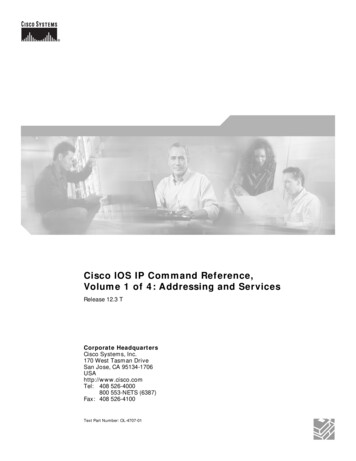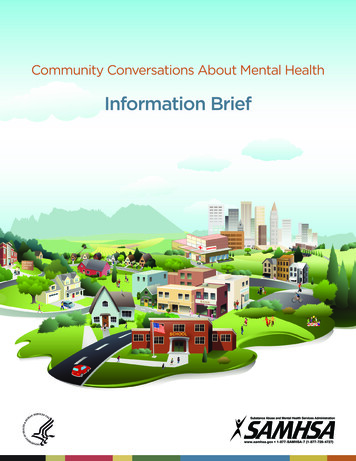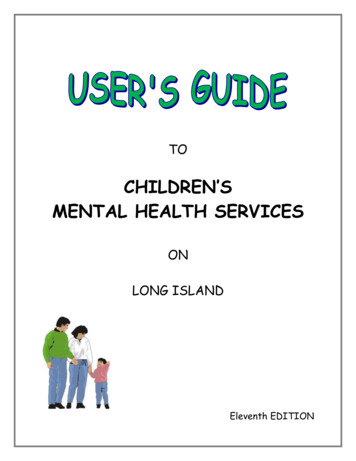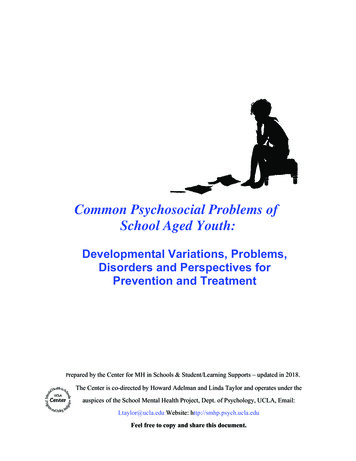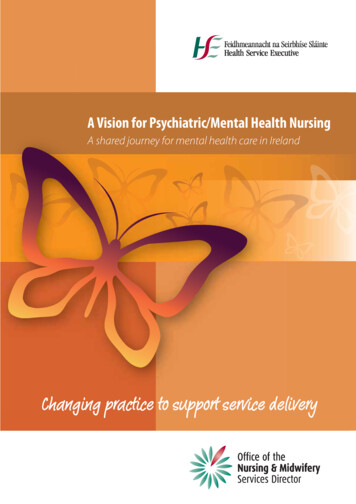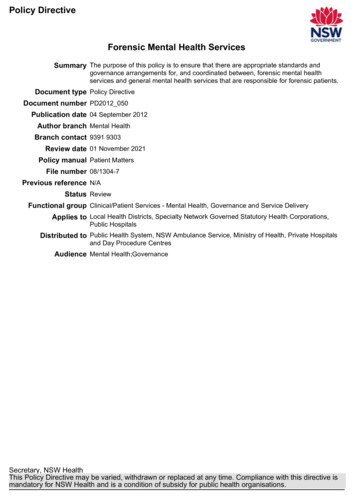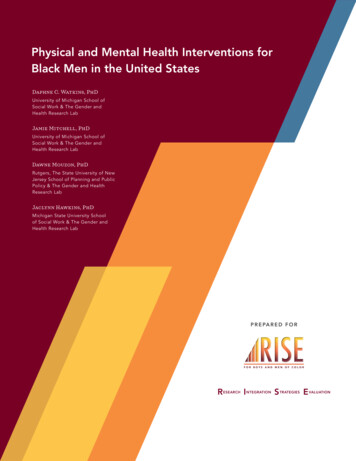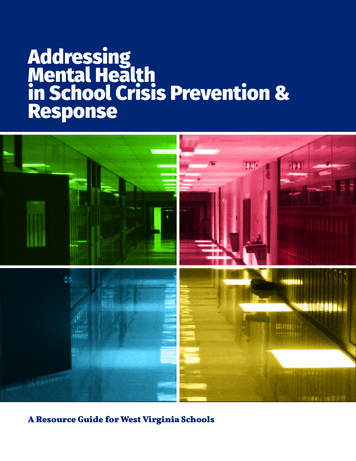
Transcription
AddressingMental Healthin School Crisis Prevention &ResponseA Resource Guide for West Virginia Schools
West Virginia Board of Education2017-2018Thomas W. Campbell, PresidentDavid G. Perry, Vice PresidentFrank S. Vitale, Financial OfficerMiller L. Hall, ParliamentarianJeffrey D. Flanagan, MemberF. Scott Rotruck, MemberDebra K. Sullivan, MemberJoseph A. Wallace, J.D., MemberJames S. Wilson, D.D.S., MemberPaul L. Hill, Ex OfficioChancellorWest Virginia Higher Education Policy CommissionSarah Armstrong Tucker, Ex OfficioChancellorWest Virginia Council for Community and Technical College EducationSteven L. Paine, Ex OfficioState Superintendent of SchoolsWest Virginia Department of Education
ACKNOWLEDGEMENTSA Resource Guide for West Virginia SchoolsThis guide was initially developed in 2014 and updated in 2017 to include recent resources and toreflect the evolution of West Virginia’s overarching school crisis template/guidance for schools.Developing and updating this guide required a tremendous amount of coordination and collaborationfrom various stakeholders who support youth in our schools in a variety of capacities. Theseindividuals willingly gave up their time, spending hours reviewing the literature, websites and guidesfrom various states and organizations to provide a much needed resource for West Virginia (WV)schools. Our initial plan was to find a guide that covered mental health implications for the fourcrisis phases and seek permission to use or revise as needed to accomplish our goal. However, whilethe literature acknowledged the need for a prevention-based approach to crisis planning, otherguides were lacking in the prevention phase. Since our goal is to provide schools with a mental healthfocused crisis planning guide that includes prevention-based best practices, much of the first twochapters is original work of our committee members. I gratefully acknowledge your great efforts andcontributions to the initial draft of Addressing Mental Health in School Crisis Prevention and Response:A Resource Guide for West Virginia Schools.It is with gratitude that I wish to acknowledge the various individuals and agencies for your hours ofdigging through websites and guides, for your rich discussions, and for your written submissions thatresulted in this helpful guide. This project, both the initial development and the revision efforts, wascross-agency collaboration at its best. I gratefully thank each of you, including: my colleagues at theWV Department of Education; WV DHHR Bureau for Behavioral Health and Health Facilities, Office ofChildren, Youth and Families; Appalachian Center for Independent Living; Cabin Creek Health Systems;Homeland Security State Administrative Agency; Department of Military Affairs and Public Safety, WestVirginia Department of Juvenile Justice and Community Service; Mission WV; WV Army National Guard(ARNG); and the WV School Health Technical Assistance Center, Marshall University.Additionally, we would like to thank and acknowledge the schools and organizations that laid thegroundwork for school crisis planning and management. Much of our work was based on informationprovided in school crisis manuals produced by other states, schools, districts and others listed in theresource section of this document.Finally, I want to acknowledge school counselors, administrators and other staff who expressed aneed for and support of this project and for the conversations that guided us in regard to the guidedesign and content. We truly hope this guide provides you with the resources you need to prevent andrespond to crisis and support the students, staff and families you engage in your schools. Your effortsare sincerely appreciated.With kind regards,Dr. Barb BradySchool Crisis Guide LeadWVDE School Counseling Coordinator Office of Student and School Supportsi
CONTRIBUTORSAddressing Mental Health in School Crisis Prevention and ResponseORIGINAL TEAM (2014)Linda Anderson, MPH CoordinatorWest Virginia School Health Technical AssistanceCenterMarshall UniversityBarbara Brady, PhDSchool Counseling Coordinator Division ofTeaching and Learning Office of SecondaryLearningWest Virginia Department of EducationPaula Fields, MSN, BSN, RN Community SchoolsCoordinator Office of Special ProgramsWest Virginia Department of EducationJoann Fleming, BAState Disaster Behavioral Health CoordinatorBureau for Behavioral Health and Health FacilitiesOffice of Consumer Affairs and CommunityOutreachMary Grandon, PA-CSchool Based Health Center Provider– Cabin CreekHealth Systems andCoordinator - West Virginia School HealthTechnical Assistance CenterMarshall UniversityJennifer Hancock, Psychologist Cabin CreekDavid Hoge, DirectorHomeland Security State Admin AgencyiiBecky KingSchool Nursing CoordinatorOffice of Special ProgramsWest Virginia Department of EducationSgt. Donald Miller, PRO OfficerWV Dept. of Juvenile Justice and CommunityServiceTiffany Pittman, LPC, AADC Child and AdolescentDivisionBureau for Behavioral Health and Health FacilitiesDallas Staples, Safe Schools Coordinator Dept. ofMilitary Affairs & Public SafetyCarolyn Suppa, Ed.D. CoordinatorOffice of Career and Technical Instruction WestVirginia Department of EducationEric TissenbaumIndependent Living Advocacy/Training SpecialistAppalachian Center for Independent Living, Inc.Vanessa VanGilder, Disaster Planner Bureau forBehavioral Health and Health FacilitiesOffice of Consumer Affairs and CommunityOutreachSusie Wilson, MAChild and Adolescent Mental Health Bureau forBehavioral Health and Health Facilities
CONTRIBUTORSA Resource Guide for West Virginia SchoolsREVISION TEAM (2017)The 2017 revision team reviewed the original guide and updated it to align with the recently updatedoverarching West Virginia Crisis Prevention and Response Template. Additionally, the revision teamupdated language to align with current best practices, reviewed guide resources, repaired broken linksand updated resources to reflect new resources available to assist with crisis planning, prevention/mitigation, response and recovery.Barbara Brady, PhD – Guide ChairSchool Counseling CoordinatorOffice of Student and School SupportsWest Virginia Department of EducationBecky KingSchool Nursing CoordinatorOffice of Special EducationWest Virginia Department of EducationKenneth BirchfieldProject AWARE CoordinatorMcDowell CountyHope M. Siler, MSWSouthern Regional DirectorPrevent Suicide WV / ASPENSheila Diaz, JDSafety CoordinatorOffice of School Facilities and SchoolTransportationWest Virginia Department of EducationCarolyn Suppa, Ed.D.Coordinator Relatives as Parents Program/KinshipCare LiaisonMission WVBarri Faucett, MADirector,Prevent Suicide WV/ASPENKelly HolmesProject AWARE CoordinatorWood CountyEric TissenbaumASM ResearchAn Accenture Federal Services CompanySubstance Abuse PreventionCoordinator, WV Army National GuardJackie PayneState CoordinatorProject AWAREElizabeth Kennedy, Program ManagerJosh VanBibberOffice of Children, Youth, and FamiliesBureau for Behavioral Health and Health Facilities Health and Human Resource Specialist, Sr.Office of Children, Youth, and FamiliesBureau for Behavioral Health and Health Facilitiesiii
FOREWORAddressing Mental Health in School Crisis Prevention and ResponseOver the last several years, school systems across the state have partnered with many organizationsincluding law enforcement, emergency management, the fire service, local health departments, theNational Guard, and other community agencies to improve the safety and security of schools acrossWest Virginia. Through these efforts, very significant improvements have been made to the physicalinfrastructure of the school facilities, emergency plans and procedures and in the coordinationbetween schools and other agencies to respond and recover from any violent incidents which mightoccur.As these efforts have matured, two realities have become apparent. First, violent incidents regrettablycontinue to take place across the country. As these incidents are reviewed, a lot of useful insight canbe garnered to further the actions and investments in our state. Secondly, the need to further shiftthe focus of school safety effort to preventing incidents is quite apparent. A very significant partof prevention is addressing the mental health needs of students and staff. While we maintain ourresponse and recovery capabilities, we need to put in place robust systems to identify and addressmental health issues and create a positive school climate and learning environment for our students.The key to preventing crisis is addressing emotional issues and managing behaviors before theyescalate. Furthermore, once a crisis occurs, schools must be prepared to address mental healthimplications to reduce further distress or secondary crises. This guide provides guidance for the nextsteps West Virginia needs to take in achieving effective prevention, response, and recovery.Working together, we can be successful in helping to assure schools provide safe and secure learningenvironments. We commend the individuals who helped assemble this guide, and the thousands ofindividuals who help students across the state realize their potential every day.David Hoge, Director Homeland SecurityState Administration AgencyivDallas Staples, Safe Schools CoordinatorWest Virginia Department of Military Affairs &Public Safety Retired Chief, Charleston PoliceDepartment
CONTRIBUTORSA Resource Guide for West Virginia Schools“A school crisis is any traumatic event thatseriously disrupts coping and problem-solvingabilities of students and school staff.”v
Addressing Mental Health in School Crisis Prevention and Responsevi
TABLE OF CONTENTSA Resource Guide for West Virginia SchoolsACKNOWLEDGEMENTS. iCONTRIBUTORS. iiFOREWORD. ivTABLE OF CONTENTS.viiINTRODUCTION.1Purpose of this guide.1What is a school crisis?.2Why mental health is important in crisis planning.2De-stigmatizing “Mental Health”.2Overview: Phases of Crisis Planning and Response.3CHAPTER 1: PREPAREDNESS. 5CHAPTER 2: PREVENTION/MITIGATION. 7CHAPTER 3: RESPONSE.11CHAPTER 4: RECOVERY. 14REFERENCES.20APPENDICES. 22Appendix 1.1: Getting Started: Checklists, Sample Manuals, Templates. 23Appendix 1.2: Establishing a School Mental Health Crisis Team. 24Appendix 1.3: WV School Mental Health Crisis Planning Template. 26Appendix 1.4: WVDHHR Support Services and ContactsAppendix 1.4.a - WV Disaster Behavioral Health Response Coordinators Contact List.36Appendix 1.4.b – Children’s Clinical Outreach Services Liaisons. 37Appendix 1.4.c - WVDHHR Contracted Homeless Shelters Contacts and Services.40Appendix 1.5: Sample Role DescriptionsAppendix 1.5.a - School Counselor/Crisis Team Manager.48Appendix 1.5.b - Principal.51Appendix 1.5.c - School Nurse. 53Appendix 1.5.d - Community Mental Health Provider. 55Appendix 1.5.e - School-based Mental Health Provider.56Appendix 1.5.f - School Resource Officer.58Appendix 1.5.g - Team member. 59Appendix 1.5.h - Special Needs Coordinator.61Appendix 1.5.i - Blank Role Description Template. 63Appendix 1.6: West Virginia Resources for School Mental Health Crisis Planning.64Appendix 1.7: Emotional and Behavioral Health Considerations forStudents with Disabilities and Other Vulnerable Students. 65Appendix 1.8: Resources for Vulnerable StudentsAppendix 1.8.a Resources for Students with Special Needs and Other Vulnerable Students.69Appendix 1.8.b WV Transition Specialists.71Appendix 2.1: Mental Health Crisis Resources for School .73Appendix 3.1: Response Stages and Interventions.77Appendix 3.2: Crisis Response Resources for Parents, Caregivers and Educators.77Appendix 4.1: School Crisis Recovery Resources for Parents, Caregivers and Educators. 79vii
Addressing Mental Health in School Crisis Prevention and Response“Effective crisis management does not start withthe critical incident response. It encompassesfour integrated phases: preparedness,prevention and mitigation, response, andrecovery.”(Reeves, Brock, & Cowan, 2008)viii
INTRODUCTIONA Resource Guide for West Virginia SchoolsPurpose of this guideThis guide is aimed at assisting schools to move to the next phase of implementation of WV StateCode §18-9F-9: School Access Safety Act which stipulates that schools shall develop and annuallyrevise a comprehensive crisis plan. This guide addresses mental health considerations for crisisplans that are required by Policy 2315: Comprehensive School Counseling Programs. The guideprovides resources, tools and recommendations for incorporating best practices related to mentalhealth into the school crisis plans to address the four phases of school crisis: planning, prevention/mitigation, response and recovery. This guide provides credible resources and outlines evidencebased practices to support each school in easily customizing their prevention and response plansand is organized by chapters addressing each of the four phases.The guide includes sample charts in Appendix 1.5 to assist schools with understanding andassigning staff member roles and responsibilities during each crisis phase. Other planning toolsand resources provide the school crisis planning team with recommendations and best practicesfor each crisis stage, including how to address the needs of your most vulnerable students. TheSchool Mental Health Crisis Planning Team (SMHCPT) will examine the various crisis resources forleaders, parents, caregivers and educators and determine which resources you will utilize and/orrevise to include in your school plan to address school needs during each crisis phase.SCHOOL PLAN DEVELOPMENT AND ANNUAL REVISIONS:Using resources found in this guide, the school counselor will lead the school crisis team to developand routinely update the mental health component of your school’s crisis plan, using Appendix 1.3:WV School Mental Health Crisis Planning Template.Instead of reinventing the wheel, as you develop and revise the mental health component of yourschool’s crisis plan, we recommend you begin with two helpful resources:Appendix 1.1: Getting Started: Checklists, Sample Manuals, TemplatesAppendix 1.2: Establishing a School Mental Health Crisis Planning TeamYour school’s updated plan shall be presented annually to your superintendent as soon as possibleafter the beginning of each school year and after any major revision. It is strongly recommendedthat the School Mental Health Crisis Planning Team meets monthly to continue to updating thisguide to ensure there is an effective prevention, response and recovery plan for every incidenttype that could present within a school. “Effective crisis management does not start with thecritical incident response. It encompasses four integrated phases: preparedness, prevention andmitigation, response, and recovery.” (Reeves, Brock, & Cowan, 2008)1
INTRODUCTIOAddressing Mental Health in School Crisis Prevention and ResponseWhat is a school crisis?A school crisis is any traumatic event that seriously disrupts coping and problem-solving abilities ofstudents and school staff. It is typically sudden, unexpected, dramatic and forceful and may eventhreaten survival. A crisis can present a drastic and tragic change that is generally overwhelmingand uncontrollable, as well as, as unwanted and frightening. It may create a sense of helplessness,hopelessness, and vulnerability combined with a loss of safety. School crises can be large scaleevents (severe violence, sniper attack, hostage situations, natural disasters, mass transportationaccident, fire or chemical spill, etc.) that require the school to activate the Incident CommandCenter engaging community emergency agencies as outlined in each county’s emergency responseplan. Other crises may be on a smaller scale (student or teacher is diagnosed with cancer, caraccidents, sudden unexpected death, etc.) that can be addressed through thoughtful, best practiceprotocols designed by the crisis team to address needs, contributing to a positive, supportiveschool environment.Why mental health is important in crisis planningTraumatic experiences can affect student mental health and school staff and the ability to teachand learn. Having a comprehensive system of school mental health services and supports alreadyin place will assist schools better address the ensuing mental health needs that arise with anycrisis. By preparing in advance, schools may prevent crises and are better prepared to address theneeds of impacted students, including vulnerable students and staff, should a crisis occur. It isimportant to understand the impact of these traumatic events on student and staff mental health.Failure to adequately address mental health issues may result in secondary trauma or even posttraumatic stress syndrome (PTSD) that can result in the inability to focus, poor school performance,substance abuse, inflicting abuse on self and others, and even additional school violence (SonomaGuide). Therefore, it is critical that schools understand and implement best practices to addressmental health issues.Promoting a Positive Concept of "Mental Health"Mental health is defined as a state of well-being in which every individual realizes his or her ownpotential, can cope with the normal stresses of life, can work productively and fruitfully, and isable to make a contribution to her or his community (World Health Organization, 2013). Although,the term “mental health,” often is used in a way that implies dysfunction; in fact, sound mentalhealth should be a goal for everyone. Schools should educate staff, students and families about theimportance of maintaining good mental health just as they work to maintain good physical health.Researchers identify three domains and several indicators of mental health: Emotional well-being - perceived life satisfaction, happiness, cheerfulness, peacefulness. Psychological well-being - self-acceptance, personal growth including openness to newexperiences, optimism, hopefulness, purpose in life, control of one’s environment, spirituality,self-direction, and positive relationships. Social well-being - social acceptance, beliefs in the potential of people and society as a whole,personal self-worth and usefulness to society, sense of community. (Keyes, 1988; Ryff, 1989; Ryfe& Keys 1995).2
INTRODUCTIONA Resource Guide for West Virginia SchoolsOverview: Phases of Crisis Planning and ResponseIt is essential that schools take a prevention-based approach to crisis planning.Effective crisis management does not start with the critical incident response. Itencompasses four integrated phases: preparedness, prevention and mitigation, response,and recovery. Activities within each of the four phases are developed and overseen by aschool mental health crisis planning team (SMHCPT) members who ae trained in the typesof crises, systems, procedures, and unique needs that arise as the result of a crisis. TheSMHCPT should address crises as physical and mental health and safety risks within thecontext of the school culture. (Reeves, Brock, & Cowan, 2008).Preparedness. Preparedness consists of several steps including: creation of school mental health crisis planning and response teams; identification of community mental health resources; identification of psychologically vulnerable students and staff; scheduled exercises or drills, education of the mental health school response team; and annual training of staff on procedures, practices, policies, and protocols, as well as, trainingand orientation of new staff.Prevention/Mitigation. The key to prevention is reducing incidents and managing behaviorsbefore they escalate. Awareness, knowledge, and practices that promote sound mental health cangreatly reduce and often prevent a crisis. While educating students is the primary mission of everyschool and teacher, schools must provide students a safe and supportive learning environment.A strong emphasis on prevention is a central component of any comprehensive school crisis plan.Prevention needs to be multifaceted and comprehensive. It is an ongoing, long term effort topromote positive school climate, healthy student development, prevent problems, and respond assoon as problems are identified and includes: addressing specific topics that may lead to a school crisis (i.e. gangs, violence, bullying, fights,anger management, suicides, depression, substance abuse, domestic violence); implementing primary prevention programs (i.e. Support for Personalized Learning, PositiveBehavior Interventions and Supports (PBIS), Comprehensive School Counseling Programs,Expanded School Mental Health); identifying at risk students; linking school-based mental health counseling and community services; and providing staff training programs (i.e. Mental Health First Aid and Trauma Sensitive Schools)to assist staff with identifying vulnerable students, responding appropriately and makingappropriate referrals.The West Virginia (WV) School Counseling Model outlines a three-tier process to address the socialemotional needs of students requiring school counselors to integrate with other multi- tieredapproaches such as PBIS and Expanded School Mental Health (ESMH). WV’s ESMH website / provides rich resources for schools regarding this three-tiered framework of prevention, earlyintervention and treatment including best practices and tools and resources about developingschool based mental health services.3
INTRODUCTIOAddressing Mental Health in School Crisis Prevention and ResponseResponse. The primary focus of crisis response is restoring equilibrium to address immediate andshort-term mental health needs of students and staff, and in many cases parent(s) or guardian(s)of involved students. During this phase schools must contact and utilize the school and communityprofessionals who were identified during the planning stage to address the specific crisis. Themental health crisis response team will support students and staff in a calm and nurturing mannerteaching appropriate evidence-based coping strategies, problem- solving and decision-makingstrategies designed to restore equilibrium. Crisis response professionals identify students and staffwho need follow-up during the recovery phase and begin connecting them with initial resourcesto address immediate and short-term needs. In the aftermath of a crisis or disaster, mental healthinterventions are designed to reduce stress and foster adaptive coping for the survivors (NCTSN/NCPTSD, 2006).Recovery. The ongoing process of restoring the social and emotional equilibrium of the schoolcommunity by promoting positive coping skills and resilience in students and adults is recovery.Most students and staff do recover with the support and assistance of caring educators andmental health professionals. In all phases of recovery, schools provide the greatest degree ofsupport when their routines and social activities are maintained. These routines and activitiesprovide natural places where experiences can be shared and preserve the sense of belonging andsolidarity so crucial to students and staff after a crisis. Recovery includes immediate and ongoingsupport both short and long term for individuals and the entire community affected by the crisis.4
CHAPTER 1 PREPAREDNESSA Resource Guide for West Virginia SchoolsChapter 1- CRISIS PREPAREDNESSDefinitionPreparedness is the state of readiness to respond to a disaster, crisis or other event.RationalePreparedness is simply a good idea in the event that a situation may occur. Anticipating and takingprecautionary measures for future events, crises or disasters reduces fear and increases the abilityof rapid recovery following the event.Best PracticesEach school will appoint 1-2 school staff (usually the school counselor) to form and coordinatea mental health crisis planning team (MHCPT) as a subcommittee of the school crisis team. EachMHCPT is responsible for developing and implementing the mental health component of theschool’s crisis plan. Activities include:1. Review the WV Guide for Addressing Mental Health in Crisis Prevention and Response andother resources to understand the mental health component of school crises and identifybest practices. See Appendix 1.1 – Getting Started2. Form a school-community planning team that will meet regularly to develop, evaluate, andrevise mental health crisis plan.3. Develop school protocols for addressing each phase of a school crisis.4. Maintain up to date contact lists of community resources and mental health responders;review and review at least quarterly.5. Ensure that mental health responders are adequately trained and qualified.6. Identify and/or develop resources for assisting staff, students and families in each phase of aschool crisis.7. Define roles and responsibilities of the School Mental Health Crisis Response team8. Define roles and responsibilities of school staff members and community stakeholders.9. Meet with the primary school crisis team regularly to ensure they are aware of plans and bestpractices related to mental health in each phase of a school crisis.10. Provide training on roles and responsibilities for crisis team members and staff. See examplesin Appendix 1.5.11. Engage communities and families in preparedness and prevention efforts.12. Establish relationships with local mental health professionals and agencies as well as thecommunity-based organizations specializing in disaster and trauma.13. Develop specific plans for students with special needs and other vulnerable students.14. Develop crisis and emergency-response protocols, practices, and materials around mentalhealth area
crisis phases and seek permission to use or revise as needed to accomplish our goal. However, while the literature acknowledged the need for a prevention-based approach to crisis planning, other



